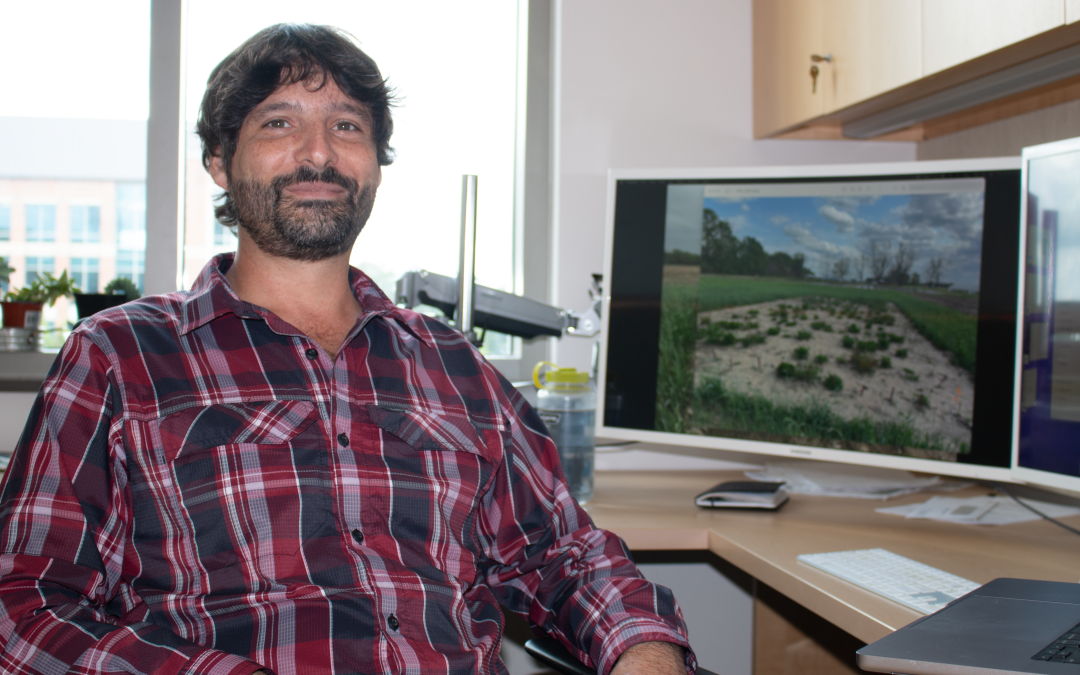An Auburn University researcher’s project is part of a $16.2 million U.S. Department of Agriculture National Institute of Food and Agriculture (USDA-NIFA) effort to address breeding crops for the future.
The Plant Breeding for Agricultural Production program area priority in the Agriculture and Food Research Initiative provides funding for fundamental, innovative breeding research across a wide variety of agronomic crops, specialty crops, wild relatives and timber species relevant to U.S. agriculture. The Auburn project is one of 32 nationwide.
Marnin Wolfe, a researcher in the Alabama Agricultural Experiment Station and assistant professor in quantitative genetics in the College of Agriculture’s Crop, Soil, and Environmental Sciences Department, is leading a $300,000 project entitled “Leveraging genomic and phenomic selection to breed better cover crop and forage mixtures, faster.”
The Wolfe Lab uses genetics, genomics and breeding to generate sustainable solutions to crop production challenges. It is focused on harnessing the benefits of cover crops to build sustainable agriculture systems.
“Cover cropping is the increasingly common practice of planting a crop between cash cropping seasons to protect and improve soil health,” Wolfe said. “The species used as cover crops also serve another critical purpose: forage production. Forages are crops planted to feed livestock, and livestock are a multi-billion dollar industry in the U.S.”
The Wolfe Lab will implement novel applications of genomic and phenomic prediction in intercrop breeding trials.
“Our specific focus is on developing a dual-purpose forage and cover crop mixture of crimson clover (Trifolium incarnatum) and oats (Avena sativa) with enhanced intercrop-ability and overall performance,” Wolfe said. “Beyond clover and oat mixtures, the strategy we are piloting holds the potential to accelerate the development of better mixtures in many additional intercropping systems.”
Breeding for intercrops is a massive combinatorial problem, which has limited the development of intercrop-adapted cultivars, he explained.
“Typically, multiple crop species are grown together because they improve biomass,” Wolfe said. “The best combination of varieties is crucial for optimal outcomes. While existing research has primarily focused on agronomic management of species mixtures, they have relied on cultivars developed under monocrop conditions. It is clear that intercrop conditions create a distinct environment and thus, dedicated breeding efforts are needed to unlock their full potential.”
Wolfe’s lab is addressing these long-standing challenges with genomic prediction, which is a technique for using DNA sequence information to forecast the potential outcomes of inheriting different combinations of genes.
Genomic prediction has revolutionized the field of genetics, speeding up the results of plant and animal breeding. It is also used to assess the risk for inheriting genetic diseases in humans.
“We are going to grow out a large collection of clover varieties and test them in combinations with many different oats,” he said. “We’ll use drones to monitor growth and development of our clover-oat mixtures. In parallel, we will collect DNA from all of our clovers and our oats.
“We will develop models to predict the performance of previously untested combinations, based only on genomic information. Because we cannot test all combinations practically, our goal is to be able to predict which clover-oat combinations are most promising so we can focus on testing those in the field.”
Collaborators on the project include Alvaro Sans-Saez, assistant professor in the Department of Crop, Soil & Environmental Sciences; Yin Bao, assistant professor in the Department of Biosystems Engineering; and Esteban Rios, assistant professor in forage breeding and genetics at the University of Florida.

